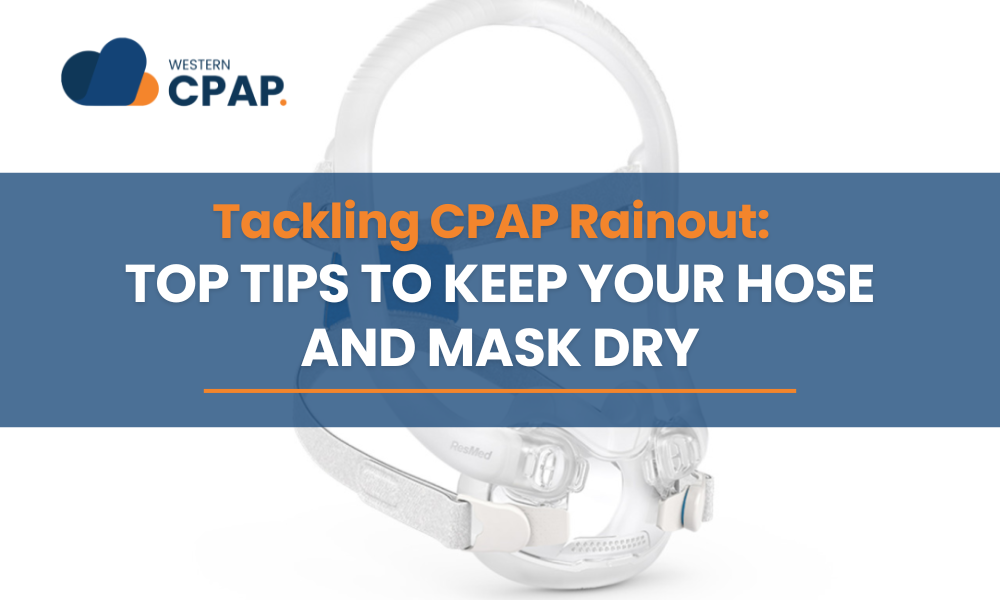- Free Shipping Options Available On Orders Over $300
- Price Match Guarantee
- FAQ
Tackling CPAP Rainout: Top Tips to Keep Your Hose and Mask Dry
Are you struggling with CPAP rainout, causing water to collect in your hose and mask during therapy? It can be frustrating to wake up feeling damp and uncomfortable, but there are solutions to keep your equipment dry and your sleep apnoea therapy effective.
CPAP rainout is a common problem and at Western CPAP, we have helped many of our clients to implement measures that have helped prevent it. In this article, we will discuss the impacts of CPAP rainout, the role of humidity in prevention, the advantages of using heated CPAP tubing, practical tips for prevention, and when to seek professional help.
CPAP Rainout and Its Impacts on Your Therapy
Encountering CPAP rainout can be more than just a nightly nuisance; it has tangible effects on the quality of your sleep apnoea therapy. When the warm, moist air from your CPAP device cools and condenses in the hose and mask, it can lead to a rather unpleasant wake-up call – a face dampened by water droplets. This discomfort may not only disturb your sleep but also compromise the effectiveness of your therapy.
The presence of water in your mask or hose can alter the pressure that’s being delivered, potentially leaving your sleep apnoea symptoms unchecked. Imagine trying to achieve a good night’s rest, only to be thwarted by interruptions caused by rainout. It’s vital to acknowledge the role that maintaining a dry CPAP system plays in ensuring your treatment remains as efficient and comfortable as possible.
Understanding the impact of CPAP rainout is the first step towards finding a solution that keeps you dry and ensures your therapy continues to provide the benefits it’s designed to.
The Role of Humidity in CPAP Rainout Prevention
Navigating the delicate balance of humidity in your CPAP machine is like finding that sweet spot where comfort meets effectiveness. Humidity plays a pivotal role in preventing CPAP rainout, acting as a guardian against those unwelcome water droplets in your hose and mask.
Adjusting the humidity settings according to both your personal preference and the room’s ambient conditions can significantly minimise the risk of condensation. It’s a bit of a balancing act, though. Too little humidity and you might find the air uncomfortably dry, too much and you’re back to battling rainout. Discovering the ideal setting requires a bit of experimentation, but once you hit upon the right level, it can transform your sleep apnoea therapy experience. Think of it as fine-tuning your machine to work in harmony with the environment, ensuring a dry, comfortable night’s sleep without compromising on the quality of your therapy.
Keeping an eye on these settings as the seasons change is also a smart move, as what works in the humid days of summer might need adjusting come the chill of winter. Embracing this control over your device empowers you to optimise your sleep therapy, steering clear of CPAP rainout and towards restful nights.
Advantages of Using Heated CPAP Tubing
Heated CPAP tubing is a standout solution in the battle to control CPAP rainout. By integrating a heating element that runs the length of the tubing, this innovative design keeps the air at a steady, warm temperature from the machine all the way to your mask.
This constant warmth does wonders in preventing the cool-down effect that typically results in condensation forming within the tube. A step beyond the standard setup, heated tubing essentially ensures that the moisture-rich air you breathe remains in perfect harmony with your therapy needs, bypassing the pitfalls of rainout with ease.
For individuals who frequently find themselves grappling with moisture in their mask and hose, upgrading to heated tubing can mark a turning point, transforming a potentially fitful night’s sleep into a seamless, uninterrupted dream. It’s not just about keeping dry; it’s about maintaining the optimal environment for your therapy, making each breath as beneficial as the last. Opting for heated CPAP tubing can be the key to unlocking a more comfortable, more effective sleep apnoea therapy regimen, letting you say goodnight to rainout for good.
Practical Tips for CPAP Rainout Prevention
To successfully combat CPAP rainout and keep your nights uninterrupted, consider adopting a few practical measures.
- Position your CPAP machine on a lower surface compared to your bed. This strategic placement allows any accumulated water to flow effortlessly back into the humidifier, rather than loitering in your mask or hose.
- Maintaining a stable room temperature can significantly deter fluctuations in humidity levels, which in turn reduces the likelihood of condensation.
- A clever hack is to insulate your CPAP tubing with a dedicated hose cover; this simple addition can minimise heat loss, thus preventing the unwanted guest that is condensation.
- Additionally, integrating a CPAP humidifier into your setup can profoundly enhance moisture levels in the air before it journeys through your tubing, offering a bespoke balance between humidity and comfort.
Embrace these adjustments with an open mind, as they hold the potential to transform your sleep therapy experience, steering you away from the pitfalls of rainout and towards a serene, uninterrupted night’s rest.
When to Seek Professional Help
If, after implementing these tips, you find that CPAP rainout continues to dampen your sleep therapy efforts, it’s wise to consider consulting with professionals, like the team at Western CPAP. This doesn’t mean you’ve failed; rather, it’s about tapping into a deeper well of expertise to fine-tune your CPAP setup for optimal performance.
Your healthcare provider or a specialist in CPAP therapy can conduct a thorough review of your equipment and usage patterns. They may suggest adjustments to your machine’s settings or propose alternative equipment, such as a different type of tubing or humidifier, that could better suit your individual needs.
Remember, every person’s journey with sleep apnoea therapy is unique, and sometimes, achieving the perfect setup requires a bit of professional insight. Seeking help is a proactive step towards enhancing your sleep quality and ensuring your CPAP therapy is as effective and comfortable as possible.
Achieve a Dry and Comfortable CPAP Experience with Western CPAP
CPAP rainout can significantly disrupt your sleep therapy but understanding its causes and implementing effective solutions can help you maintain a dry and comfortable setup. From adjusting humidity levels to utilising heated tubing, there are numerous strategies to combat condensation and enhance your CPAP experience.
Don’t let CPAP rainout dampen your sleep quality. Visit Western CPAP for expert advice and top-notch CPAP solutions tailored to prevent rainout and ensure effective therapy. Explore our range of products at Western CPAP, or contact us on (08) 61851856, and take the first step towards uninterrupted, restful nights.





